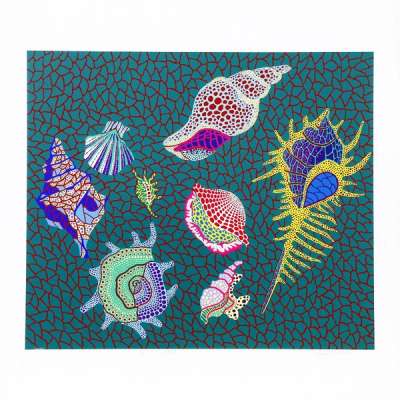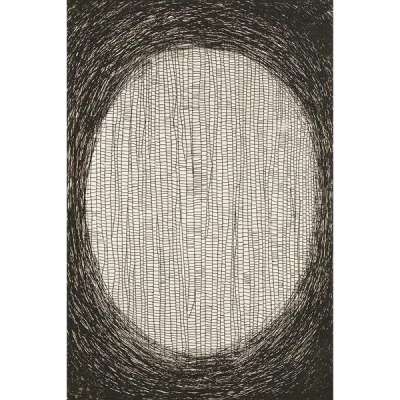 Madder-colored Cloud, Kusama 237 © Yayoi Kusama 1997
Madder-colored Cloud, Kusama 237 © Yayoi Kusama 1997
Yayoi Kusama
290 works
Key Takeaways
Kusama’s creative journey is a compelling story of transformation, as she left traditional post-war Japan to find her place in New York's vibrant art scene of the 1950s and 60s. Her work bridges the deeply personal and the universal, evoking both the intensely private world of her inner struggles and the vast, unending patterns of the cosmos, rendering her art a unique expression of both her experiences and her inspirations. Inspired by American artists like Georgia O’Keeffe, who exemplified bold self-expression, and the Abstract Expressionists, who encouraged her unrestrained style, Kusama’s work is a blend of homage and fiercely original vision.
Yayoi Kusama is celebrated across the globe for her profoundly immersive art, which spans painting, sculpture, performance, literature, and fashion. Her signature motifs, such as swirling Infinity Nets and playful polka dots, invite viewers to step into worlds that feel boundless, as if dissolving the limits between the self and the universe. But beneath the surface of her visionary art lies a rich, complex tapestry of inspirations, woven from both personal experience and the creative spirits of artists who came before her. Themes of infinity, mental health, and self-obliteration anchor her work, but these ideas were shaped and sharpened by her early exposure to pioneering figures in modern art.
Georgia O’Keeffe: A Mentor from Afar
From her early days as an artist in Japan, Kusama found a powerful source of inspiration in American modernist Georgia O’Keeffe, whose bold explorations of nature and personal style resonated deeply with her. At a time when Kusama felt constrained by the expectations of her traditional Japanese environment, O’Keeffe’s work offered a vision of possibility; art that was both intimate and expansive, rooted in the personal yet universally resonant. Driven to follow in O’Keeffe’s footsteps, Kusama wrote to her, asking for guidance on navigating the art world as an aspiring young artist. To Kusama’s surprise, O’Keeffe responded, encouraging her to move to the United States.
O’Keeffe’s influence is woven throughout Kusama’s work, particularly in her use of bold, organic forms and recurring motifs with layers of emotional significance. Kusama’s iconic polka dots and pumpkins echo O’Keeffe’s fascination with the shapes, cycles, and rhythms of nature, reflecting a shared appreciation for beauty in simplicity and repetition. Through O’Keeffe’s example, Kusama embraced her own vision, ultimately creating work that, like O’Keeffe’s, remains both deeply personal and universally resonant.
Abstract Expressionists: Finding Freedom and Form
When Kusama arrived in New York in 1958, she stepped into the heart of the booming Abstract Expressionist movement, an era defined by artists like Jackson Pollock, Mark Rothko, and Barnett Newman. These painters had redefined the possibilities of art with sweeping canvases, gestural forms, and an intensity that transcended traditional representation. The movement was not merely about visual aesthetics; it was a radical approach to exploring raw emotion, freedom, and the unconscious mind. For Kusama, who had trained in Japan’s highly formal Nihonga style, Abstract Expressionism presented a pathway to liberation, a chance to cast off constraints and dive into her own psyche, unbound by convention. The movement’s focus on expression over form and its immersive, larger-than-life scale resonated with her deeply, inspiring her to transform her vision into something boundless and raw.
Influenced by these ideas, Kusama began her groundbreaking Infinity Nets series, vast canvases covered with delicate, repetitive nets and dots that seemed to stretch endlessly. These paintings became her signature, embodying her fascination with themes of infinity and self-obliteration. Each brushstroke was deliberate yet part of a larger whole, reflecting her inner compulsion to lose herself within the act of creation. Through these works, she sought to convey the sensation of dissolving into something infinite, as though the self were merging with the universe in a single, continuous flow. The Abstract Expressionist influence also extended to her performance art, where Kusama embraced large-scale installations and public happenings. Like the Abstract Expressionists, she valued the immersive experience of art, turning her work into an ongoing conversation between artist, viewer, and environment; a reflection of her desire to push beyond the boundaries of art itself.
Donald Judd and Minimalism: The Power of Repetition and Form
Kusama’s journey through the vibrant New York art scene of the 1960s introduced her to the rising wave of Minimalism, particularly the work of Donald Judd, a key figure in the movement. Judd’s art, with its precise forms and commitment to reduction, expressed a purity and simplicity that resonated with Kusama’s own love for repetition and pattern. In a world dominated by Abstract Expressionism’s gestural energy, Judd’s minimalism presented a new kind of engagement with space and form, distilling art to its essential components without sacrificing depth or intensity. Judd, who admired Kusama’s relentless dedication and intricate Infinity Nets, became a friend and vocal advocate for her work, writing one of the earliest critiques of her art and praising her ability to evoke depth through simplicity.
Inspired by Judd’s philosophy, Kusama continued to explore minimalist techniques as vehicles to convey her inner visions of boundlessness and infinity. She extended her approach beyond painting, incorporating mirrors, polka dots, and immersive installations that dissolved the viewer’s sense of physical limits. Like Judd’s sculptures, which defied conventional spaces, Kusama’s mirror rooms and otherworldly environments create surreal realms that invite viewers into an expansive, meditative experience. This shift marked a transformation in Kusama’s art; rather than merely producing objects, she was crafting entire environments that could immerse and engage the senses. Judd’s minimalist principles encouraged Kusama to distil her complex internal landscapes into experiences that felt boundless yet intensely personal, redefining art as an intimate and multidimensional encounter with the infinite.
Childhood Hallucinations and Mental Health: The Roots of Kusama’s Vision
Kusama’s distinct artistic vision, characterised by her iconic polka dots and Infinity Nets, has deep roots in her early experiences with mental health struggles and recurring hallucinations. Growing up in Matsumoto, Japan, Kusama’s childhood was punctuated by vivid hallucinations that filled her world with flashing lights, dense fields of dots, and all-consuming patterns. These visions, which often alternated between wonder and fear, shaped her worldview, transforming everyday surroundings into dreamlike landscapes. For Kusama, these early encounters with altered perceptions of reality created an inner world that she felt compelled to capture through her art. Creating became a form of self-preservation, a therapeutic way to externalise her anxieties and bring order to the overwhelming experiences that she faced daily.
Kusama has openly shared how her work serves as a therapeutic outlet, allowing her to confront and reinterpret these profound hallucinations. She began to see art as a form of meditation, a way to process and gain control over her fears by methodically filling canvases with polka dots and patterns that mirrored her visions. Each dot became a representation of the infinity that once terrified her, a means of bridging her inner turmoil with a calming, repetitive structure. Since 1977, she has chosen to live in a psychiatric institution in Japan, where she continues to produce art that reflects her ongoing journey with mental health. Through installations like her Infinity Rooms, Kusama invites viewers to step into her world, to experience her vision of endlessness and self-obliteration, and to confront the interplay between individuality and the universe. In sharing her personal universe, Kusama brings viewers face to face with her journey, where vulnerability, resilience, and a profound acceptance of her reality converge to create immersive spaces of self-reflection and shared wonder.
The Cosmos and the Pumpkin: Symbols of Infinity and Whimsy
Throughout Kusama’s career, two contrasting yet deeply resonant motifs have embodied the duality of her artistic vision; the vastness of the cosmos and the simplicity of the pumpkin. For Kusama, polka dots symbolise both the endlessness of the universe and the concept of self-obliteration, where the individual dissolves into a boundless, interconnected whole. Inspired by her childhood hallucinations, she began to interpret each dot as a star, particle, or cell, part of an infinite network. Through her Infinity Rooms and sprawling dot patterns, Kusama creates environments that replicate this vision, inviting viewers to experience her perception of endless space, where one’s sense of self merges with the cosmic vastness. These immersive installations are visual journeys into themes of unity, eternity, and existential reflection, embodying Kusama’s desire to express the cosmic infinity she saw as a child and has carried with her throughout her life.
In contrast, the pumpkin brings a more grounded, comforting element to her work. Kusama first encountered pumpkins growing on her family’s farm in Japan, where their round, friendly forms offered a sense of warmth and security. Unlike her cosmic themes, which convey an abstract infinity, her pumpkins symbolise life’s modest beauty and the strength in simplicity. Kusama has described them as embodying resilience and joy, noting that they are “humble and amusing”, yet filled with tender strength. By frequently returning to this motif, she brings a sense of finitude and familiarity to her otherwise boundless themes, blending simplicity with depth. In her work, the pumpkin ultimately stands as a symbol of grounded stability within the infinite, a reminder that, amid the vast cosmos, there is comfort and joy in the familiar and everyday. Together, the cosmic and the pumpkin represent Kusama’s philosophical approach; that the boundless and the humble each contain mysteries worth celebrating, each a reflection of our place within an infinite, interconnected world.
As we trace the artistic roots and inspirations that shaped Kusama, we uncover both her courage to confront her inner world and her unrelenting drive to transform these visions into universally resonant art. Kusama’s work, shaped by her encounters with pioneering figures and movements, become a tribute to her mentors as well as a testament to her singular vision. These influences coalesce into Kusama’s unmistakable style; a seamless fusion of personal history, mental landscapes, and cosmic inquiries that push viewers to ponder the profound connections between self and universe, chaos and order, infinity and intimacy. Her work is a living dialogue with her inspirations, inviting us all to step beyond our own boundaries and glimpse the vast, interconnected beauty of existence.

































